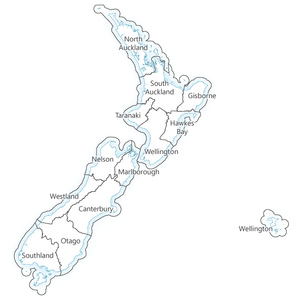While Landonline stores our property records, the accuracy of title transactions depends on precise information about the land’s features and boundaries. New Zealand’s geodetic system provides the underlying measurements.
The records of property location and related information, such as the boundary dimensions, are together called the ‘cadastre’ and are shown in cadastral survey plans.
Land registration is governed by the Land Transfer Act 2017, and associated Regulations 2002. This legislation came into force on 12 November 2018 and replaced the Land Transfer Act 1952.
The Registrar-General of Land, based within Toitū Te Whenua Land Information New Zealand, develops standards and guidelines and sets an audit and assurance programme for the land registration system.
Land registration districts
The Land Transfer Act 2017 divides New Zealand into 12 land registration districts.
All land records are organised according to those districts, so if you're ordering a copy of a record you’ll need to know the district in which the property is located.
You can view and download more detailed maps, including maps of land district boundaries, through the LINZ Data Service.

History and principles of land registration
The deeds system recorded property ownership in New Zealand before the land titles system.
The current land transfer registration system (known as the 'Torrens system') replaced the deeds system in 1870.
Use of this system is compulsory - no legal interest in land may be created except by registration under the Land Transfer Act 2017.
The principles underpinning the current land registration system are:
- Mirror principle – the register accurately and completely mirrors the state of title.
- Curtain principle – purchasers of land should not concern themselves with trusts and other interests lying behind the curtain of the register. The exception is that some public trusts can appear on titles (see section 153 Land Transfer Act 2017).
- Insurance principle – this provides state guarantee to the title and the interests registered on it and provides for losses incurred as a result of errors in the registry.
Indefeasibility is a core concept of the land transfer system. It protects the registered owner (formerly known as the ‘registered proprietor’) against claims of a competing owner, and against encumbrances, estates and interests not appearing on the register. This system is supported by the state guarantee as to the accuracy of the registered rights. Indefeasibility can be defeated if it can be proven that fraudulent activity has been carried out by the owners in obtaining the title.
How land title registration works
Practitioners (lawyers and conveyancers) lodge legal documents with us to record any changes made to titles, such as transfers of ownership, discharges of mortgage and new mortgages. We record the transaction in the record of title for that land.
How land subdivision works
Before a housing or commercial subdivision can be sold or developed, surveyors produce a cadastral survey plan. Survey plans show a property's legal boundaries, areas and dimensions.
The local authority certifies the plan to verify that it meets subdivision requirements, for example, roading and drainage services.
The surveyor lodges the survey plan with us for approval and we deposit the survey plan as a legal document, cancel the existing title, and issue a new title record for each new piece of land shown on the deposited plan.